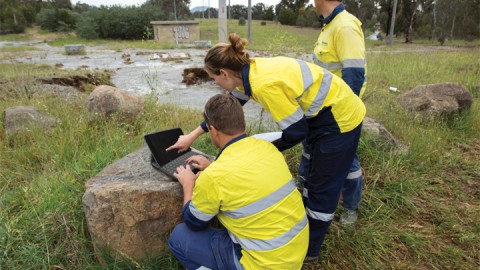by Mark Heathcote, Executive General Manager, Plastics Industry Pipe Association of Australia
A recent candid discussion between members of the Plastics Industry Pipe Association of Australia (PIPA) and a senior executive from a major utility highlighted some interesting shared experiences for both parties.
The executive focused on the scale and complexity of the issues facing his organisation over the coming decades and the need, in his view, for industry and the utility to work together strategically to better understand and address system wide challenges.
What was extraordinary was that his words could well have been those of PIPA, and from the outset, both parties were on the same page on this fundamental perspective.
The view was also that the sooner both parties did this in the life cycle of asset management, the greater the benefits for everyone, most notably the consumer.
There was a candid recognition that there was an urgent need to share expertise, particularly in the case of organisations that have lost considerable corporate knowledge over the years as a result of restructures and internal change. Both the utility and PIPA recognised the need for certain cultural change within both organisations to make this effective. From a pipe industry perspective, it needed to be acknowledged that there was a need to focus ‘beyond the next order’ and from a utility perspective, there was a genuine motivation to reach out to valued industry expertise and experience.
In short, while the systemic issues facing the utility’s network managers were unquestionably important, the manner in which they were addressed was considered to be increasingly more so. Pressure on utilities to remain at arm’s length from product suppliers for reasons of commercial probity is both understandable and accepted. Hence, it was imperative that the commercial interface remain the exclusive domain of the utility’s procurement division and the individual PIPA member companies.
For our part, this was business as usual for PIPA, as we have always strictly separated ourselves from any commercial discussion and rigorously adhered to our publicly stated goals to promote the correct use and installation of plastics pipe systems. In doing so, we safeguard product and safety standards and protect the reputation of our products, including through their entire lifecycle. This is also consistent with PIPA’s established and demonstrated commitment to continuous improvement of environmental outcomes.
Some might suggest that on one level, in commercial terms, there was little to be gained by the plastics pipe sector through improved engagement. This could be said, as plastics pipe represents more than 85 per cent of the reticulation pipeline assets going in the ground today, and they are already established as their best performing pipeline systems.
However, that is a very short sighted view and not one that PIPA shares. Our industry is here for the long-term and there simply has to be a smarter way of doing things through the sharing of expertise. It requires a more collaborative and strategic approach to long-term asset management, based on simple common sense and better and more proactive communication, based on trust, to assist with the early identification and management of issues. It is also unquestionably in the broader public interest to do so.
From PIPA’s perspective, we found the interaction with the utility instructive and helpful, primarily because of the decision on behalf of some of its senior management to be candid about the long-term systemic challenges, the need to approach them strategically and the willingness to approach them in partnership with an established and respected industry group such as PIPA. The desired outcome would be mutually beneficial. It was clear to all that the future infrastructure challenges were complex and required a more lateral and more mature approach from all parties.
For its part, PIPA has certainly demonstrated our willingness to collaborate in such a way, and there have been measured and successful steps by both parties in that spirit with positive results.
There has been a series of meetings over the last year where industry and utility representatives have sat around a table and discussed both short and long-term issues. The projects vary from the quite specific to system-wide solutions. In all cases, they addressed asset management areas that were priority hot spots involving condition assessment and problem analysis of specific asset classes, development of improved interfaces between utility and private pipeline systems, to the more strategic thoughts around making often subtle changes using different product options to maximise pipeline life and minimise future operating expenditure.
The benefits of sharing perspectives on a number of these issues have become increasingly evident to all. That’s not to say that there haven’t been a few hiccups along the way; but demonstrable progress has been made. A wider array and deeper level of relationships have been developed across both organisations.
Whilst the original motivation for this article came from that candid discussion with one executive, this position is not unique to a single agency. This may have been the first time a utility agency had made such a clear and open statement about their need for a different type of engagement, but it did however, encapsulate a view that has been developing across the gas, water and wastewater sectors over recent years.
Increasingly, PIPA is engaged in projects with agencies or their consultants looking at issues like asset risk assessment, resilience and product life cycle assessment. Increasingly, it was evident that many – if not all – of these projects required a change of mindset in terms of the strategic approach to the long-term management of the asset.
Collaboration in action
One of the highest profile examples of successful strategic collaboration, is with Queensland’s coal seam gas (CSG) industry. A significant component of their asset program was the creation of a pipeline network to gather gas and the produced water from literally thousands of individual wells.
This asset creation process needed to be achieved safely, and also needed to ensure that these long-term assets performed without the need for intervention by the asset owner for their entire design life. Plastics and most commonly polyethylene (PE) were the pipeline materials chosen to meet the environmental and operational demands of this industry.
The decision by the CSG industry to use plastics pipe meant that PIPA engaged with their peak industry group, the Australian Pipeline and Gas Association (APGA), to focus on what has become a highly successful collaborative effort developing a Code of Practice covering practically all aspects of the design, installation, testing and operation of this group of key pipeline assets. This collaborative effort involved CSG companies, contractors, designers, product suppliers and the Queensland gas technical regulator in a totally non-commercial and strategic context, based on the logical but sometimes challenging concept of sharing expertise based on trust. As a testament to the quality, integrity and relevance of the information in the Code, it is now embedded in Queensland Legislation.
The take home message is that in this changing landscape with a leaner workforce focused on core business activities, there is an increasing need to look outside the organisation for much of the specialised expertise needed to effectively make sound strategic decisions about pipeline assets.
In order to take advantage of this knowledge, there needs to be a recognition of, and respect for, the need to develop a relationship where commercial imperatives can be effectively segregated from the need to facilitate open strategic discussion. This requires a collective cultural shift across organisations and that does not occur overnight. Over time, and with common commitment, the significant mutual benefits are apparent to all, and with that comes more positive change. For our part, we have learned that the earlier we start this conversation the better, as it is simply an excellent investment for the future.
















